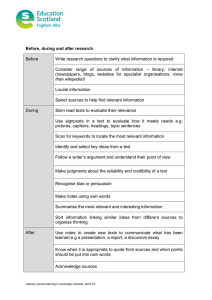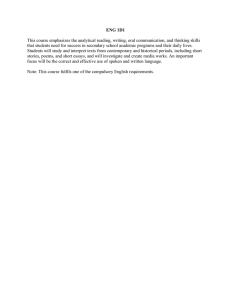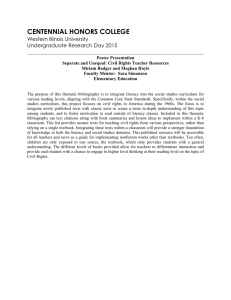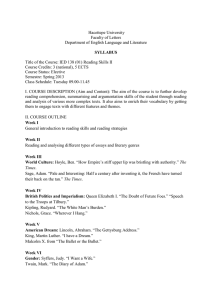Persuasion Paper Essay #1.doc
advertisement
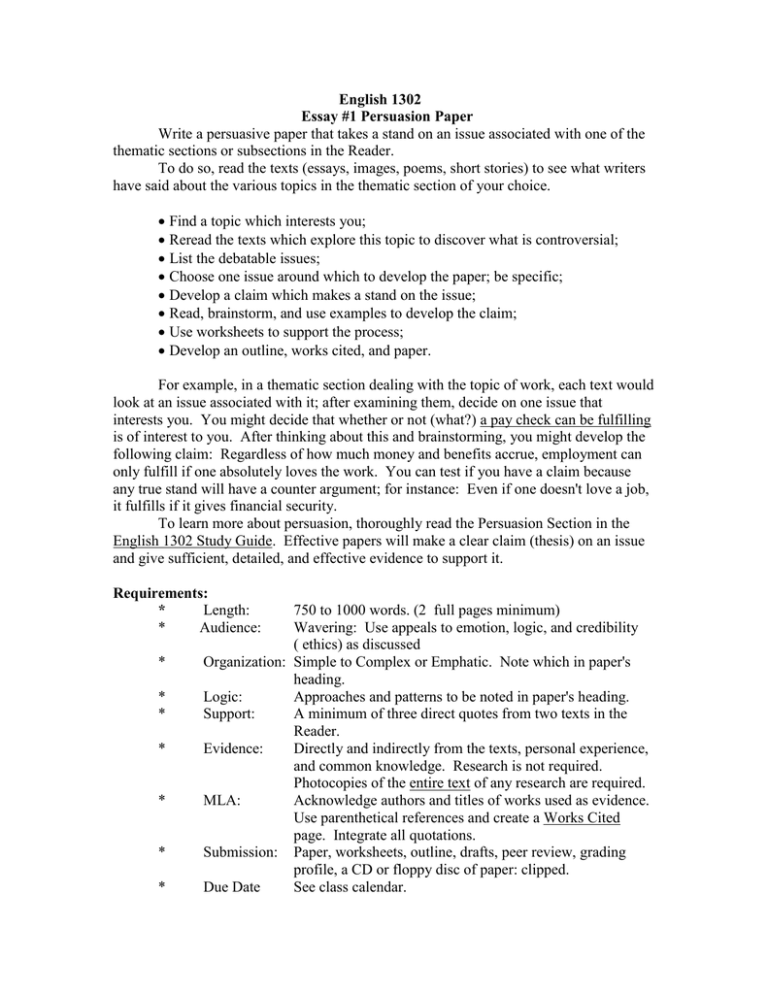
English 1302 Essay #1 Persuasion Paper Write a persuasive paper that takes a stand on an issue associated with one of the thematic sections or subsections in the Reader. To do so, read the texts (essays, images, poems, short stories) to see what writers have said about the various topics in the thematic section of your choice. Find a topic which interests you; Reread the texts which explore this topic to discover what is controversial; List the debatable issues; Choose one issue around which to develop the paper; be specific; Develop a claim which makes a stand on the issue; Read, brainstorm, and use examples to develop the claim; Use worksheets to support the process; Develop an outline, works cited, and paper. For example, in a thematic section dealing with the topic of work, each text would look at an issue associated with it; after examining them, decide on one issue that interests you. You might decide that whether or not (what?) a pay check can be fulfilling is of interest to you. After thinking about this and brainstorming, you might develop the following claim: Regardless of how much money and benefits accrue, employment can only fulfill if one absolutely loves the work. You can test if you have a claim because any true stand will have a counter argument; for instance: Even if one doesn't love a job, it fulfills if it gives financial security. To learn more about persuasion, thoroughly read the Persuasion Section in the English 1302 Study Guide. Effective papers will make a clear claim (thesis) on an issue and give sufficient, detailed, and effective evidence to support it. Requirements: * Length: * Audience: * * * * * * * 750 to 1000 words. (2 full pages minimum) Wavering: Use appeals to emotion, logic, and credibility ( ethics) as discussed Organization: Simple to Complex or Emphatic. Note which in paper's heading. Logic: Approaches and patterns to be noted in paper's heading. Support: A minimum of three direct quotes from two texts in the Reader. Evidence: Directly and indirectly from the texts, personal experience, and common knowledge. Research is not required. Photocopies of the entire text of any research are required. MLA: Acknowledge authors and titles of works used as evidence. Use parenthetical references and create a Works Cited page. Integrate all quotations. Submission: Paper, worksheets, outline, drafts, peer review, grading profile, a CD or floppy disc of paper: clipped. Due Date See class calendar. Consider and select an issue of interest to you. Read the essays in the text that pertain to or are relevant to your issue. Make a claim or contention. Based on what you read, develop your essay and persuade your read of the validity of your position. You may use the text (essays) as evidence in your paper (See above in Evidence), but you must cite your sources. (See above in MLA format.) Read the Works in the Text, Select an Issue, and Make a Claim (Not developed using our current text) Sample claims from issues in student papers: * Hajab is the covering for a lady and the proper attire for any woman whether she is Muslim or not. * Despite current ideas that not everyone is perfect, men insist women be so. We are not, and we will not be expected to be so. * While marriage is thought to be an essential ingredient to a happy and fulfilling life, it's active pursuit leads towards disaster. * Like Santa Claus and the Easter Bunny, lasting romantic love is a myth. * Advertising and marketing reinforce stereotypes which promote sexism and impede movement towards a less gender-biased society. We must boycott products sold with sexist advertising. * As in life, in death, a person must be allowed to die with dignity. * A belief in a Supreme Being is essential to understanding one's role in the universe. * Religion clouds people's minds, making it impossible to recognize truth in their daily lives. * Although a person is said to be innocent until proven guilty, the press acts as judge and jury all too often: it must be stopped.
